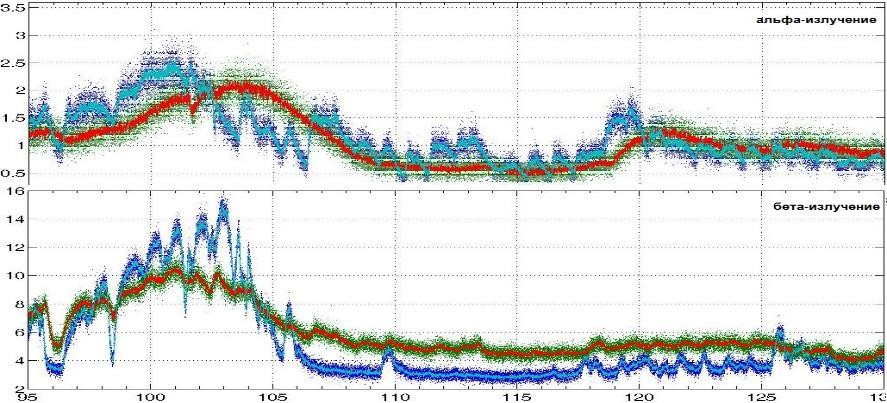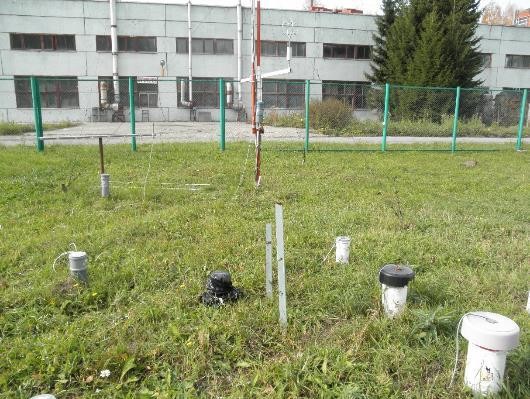Файл: Исследование суточных вариаций поровой активности радона в поверхностных грунтах удк 550. 42 546. 296 551. 51.docx
ВУЗ: Не указан
Категория: Не указан
Дисциплина: Не указана
Добавлен: 30.10.2023
Просмотров: 296
Скачиваний: 2
ВНИМАНИЕ! Если данный файл нарушает Ваши авторские права, то обязательно сообщите нам.
СОДЕРЖАНИЕ
PLANNED RESULTS OF THE DEVELOPMENT OF THE PLO/OPOP
Areas applications quantities density flow radon
Climatology. Radon - as a tracer of air exchangeprocesses
Static and dynamic methods measurements
Dynamics of radon activity and its decay products inside the storage chamber
Chapter 4 Financial management, resource efficiency and resource saving
Scientific and technical research budget
Chapter
-
Calibration of soil sensors with a radon radiometer
Work on the study of the dynamics of radioactive soil gas radon, mainly for the purpose of constructing short-term earthquake forecasts, has been carried out in many countries for more than one decade. The results of these works are well reflected in the scientific literature. In connection with this, many methods have been developed for measuring the volumetric activity of radon in soil air, which are separated, first of all, by the detected isotope (or mixture):
-
directly by radon; -
by a mixture of radon isotopes and aerosol daughter products of their decay; -
only under the LPR. The methods of measurement also differ according to the type of registered ionizing radiation - α, β or γ.
The most common measurement methods are α-radiation and pumping gas from wells, however, they are quite complex and expensive, since they require the separation of radon from the gas - aerosol mixture. Less common, but more convenient for long-term continuous monitoring of soil radon, are measurement methods for β- and / or γ-radiation of the DPR directly in wells. In addition, they are 1–2 orders of magnitude cheaper, which makes it possible to significantly increase the number of simultaneous monitoring points and thereby expand the observation network. It is these methods that have been used for decades at monitoring stations around the world to predict earthquakes. Their main advantage is that they allow obtaining, processing and analyzing data on a quasi-real scale.
One of the tasks of this research work was to check the possibility of measuring radon by direct registration in the soil using one or several
IRs. To do this, at each of the two selected depths (0.5 m and 1 m), alpha, beta and gamma radiation detectors were installed in separate wells. Figure 5 shows the time series of alpha and beta radiation fluxes measured in wells for the period from July 2010 to October 2011. In general, the seasonal changes in VA fluxes at two depths are very similar. However, if we consider the diurnal variation, the synchronism between the fluxes of α- and β-radiations is
by no means always observed. At the same time, the soil β-background varies more strongly and more often than the α-background.
During this period, 3 cases of a synchronous strong increase in VA fluxes (hereinafter referred to as anomalies) were detected in the spring and summer periods. The period of onset of the first anomaly is shown in Figure 5, where the rows at 0.5 m are shown in red, and those at 1 m are in blue. At a depth of 0.5 m, the anomaly appeared earlier than at a depth of 1 m for α-radiation. For β-radiation, almost synchronous growth is seen at both depths. The second and third anomalies in the series of VA soil fluxes are considered in detail in the next subsection.

Figure 5 - Series of soil alpha and beta fields during the snowmelt period
Analysis of the dynamics of subsoil fluxes of α- and β-radiation for 2010–2011 identified potential difficulties in the procedure for calibrating detectors and determining correction factors for converting the measurement result into RA of radon. It can be seen that a deeper study of calibration tasks is required here with parallel and long-term measurement of radon VA in wells, as well as the involvement of theoretical calculations on the transfer of IR in the "soil-well" system. It can be assumed that the correction factors for α- and β-fluxes will not be proportional, and, possibly, will be functions of one or more parameters.
Let us consider in detail the process of calibration of soil detectors for α- and β-radiation, which lasted from the beginning of June to the end of July 2011. The layout of wells at the experimental site of the TORIR, in which the detectors of α- and β-radiation BDPA- 01 and BDPB-01 are installed (ATOMTEH, Belarus), is shown in Figure 7. The appearance of the radiometer itself is shown in Figure 8. The scheme for calibrating soil detectors using the RTM 2200 radon and thoron radiometer (SARAD, Germany) is shown in Figure 9. Calibration of soil detectors was carried out from 28 May to July 28, 2011. The results of measurements of RA of radon and soil fluxes α- and β- at different depths are shown in Figures 10-12.

Figure 6 - Layout of wells with α-, β- and
γ-radiation detectors installed inside

Figure 7 - Appearance of the radon and thoron radiometer RTM
2200
- 1 ... 5 6 7 8 9 10 11 12 ... 32
Dynamics of radon activity and its decay products inside the storage chamber
The dynamics of the accumulation of radon and its decay products in the storage chamber at a constant value of RFD from the ground surface, adopted for calculations of 10 MBq m-2 s-1 (a typical value observed for loams, provided that radon transfer is carried out only by diffusion). The following parameters were selected for calculations: chamber volume – 3.14 l; height – 0.1 m, respectively, K
= 0.1 Bq m-3 s-1, accumulation time duration – 1 hour.
The radon accumulation time in the chamber with a duration of 1 hour was selected from the optimization condition. Limiting the upper limit of the range dictated by the requirement for a high sampling rate of time series of radon field data. On the other hand, when the accumulation duration is more than 2 hours, the nonlinearity of the accumulation curve begins to manifest itself strongly.

Figure 8 - Scheme of calibration of soil detectors of the VA with a radon radiometer.
- Results of measurements of radon VA and soil α- and β- fluxes at different depths



Figure 9 - Dynamics of soil fields of radon and VA from June 1
to June 15



Figure 10 - Dynamics of soil fields of radon and VA from June
16 to June 30



Figure 11 - Dynamics of soil fields of radon and VA from July
1 to July 15
Further, the results of calibration of each well separately are discussed in detail. The calibration results in a 1 m well with an alpha detector are shown in Figure 13. The upper diagram (Figure 13) shows a series of radon VA measured by a radiometer ( Rn 1 m) and restored by multiplying by the correction factor Kα1m=16940 Bq/ imp . a series of OA radon (Alpha 1 m). The lower diagram shows the rows of radon VA restored by multiplication by correction factors in 0.5 m wells with
alpha - (Alpha 0.5 m) and beta - (Beta 0.5 m) detectors. The correction factors determined for different detectors are summarized in Table 3.


Figure 12 – Calibration results in a 1 m well with an alpha
detector
Table 3 - Conversion coefficients to activity units, Bq / imp .

An analysis of the real and reconstructed radon VA series showed the following:
-
The alpha detector at a depth of 1 m does not adequately reflect
the real change in the RA of radon in the well, there are no daily variations.
-
The alpha detector at a depth of 0.5 m shows a delay in time of the moments of the onset of maxima in RA in comparison with a depth of 1 m, the delay is approximately 8 hours. The speed of radon movement is estimated to be 17 10 3 times higher than the speed of radon movement due to molecular diffusion 6·10 -4 cm/s. -
A beta detector at a depth of 0.5 m shows approximately the same delay of 8 hours. -
The change in time of alpha and beta fields at a depth of 0.5 m is almost synchronous, but with different amplitudes. The shape of diurnal variations is more like a sawtooth for beta radiation and a cycloid for alpha radiation.
Calibration results in a 0.5 m well with an alpha detector. The upper diagram shows